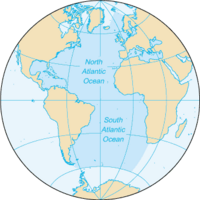
Photo from wikipedia
Abstract The loading of P into the Gulf of Finland has decreased markedly, but no overall trend in the concentration of P has been observed in the open Gulf, where… Click to show full abstract
Abstract The loading of P into the Gulf of Finland has decreased markedly, but no overall trend in the concentration of P has been observed in the open Gulf, where the concentrations of both inorganic N and P still have a pronounced inter-annual variability. Our main aim was to study whether the internal processes driven by atmospheric forcing can explain the variation in the nutrient conditions in the Gulf during the period 1992–2014. We observed that the long-term salinity variation of the bottom water in the northern Baltic Proper controls that in the Gulf, and that the deep-water concentrations of oxygen and nutrients are significantly correlated between the basins. This imposes preconditions regarding how atmospheric forcing may influence deep water flows and stratification in the Gulf on a long-term scale. We found that over short timescales, winter winds in particular can control the in- and outflows of water and the vertical stratification and mixing, which to a large extent explained the inter-annual variation in the DIN and TP pools in the Gulf. We conclude that the inter-annual variation in the amounts, ratios, and spatial distribution of nutrients sets variable preconditions for the spring and potential blue-green algae blooms, and that internal processes were able to mask the effects of the P load reductions implemented across the whole Gulf. The transportation of P along the bottom from the northern Baltic Proper and its evident uplift in the Gulf highlights the fact that the nutrient reductions are also needed in the entire catchment of the Baltic Sea to improve the trophic status of the open Gulf.
Journal Title: Journal of Marine Systems
Year Published: 2017
Link to full text (if available)
Share on Social Media: Sign Up to like & get
recommendations!